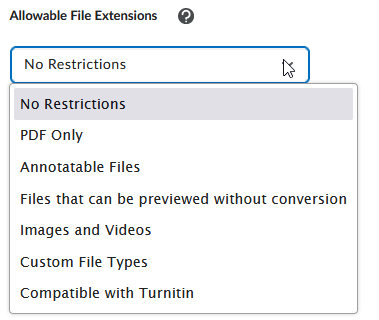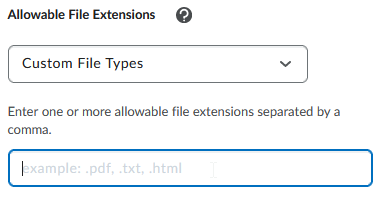The Allowable Filetypes field provides options for the types of files that learners can submit for the assignment. Options in the drop down menu include:
- No Restrictions – any file type allowed (default)
- PDF Only
- Annotatable files, which include all file types that are supported by the Annotation tool in Assignments. For the complete list of file types, see File types supported by Annotations.
- Files that can be previewed without any conversion, such as .HTM, .HTML, .MHT, .MHTML, and .BMP
- Images and videos
- Custom File Types
- Compatible with Turnitin – restricts submission to file types that Turnitin is capable of analyzing (if Turnitin is enabled)

If you choose Custom File Types, you can then enter file extensions that are allowed for file submissions.
Note: Not all file types can be viewed within Brightspace. Particularly with Custom File Types, be aware that some file types might require you to download the files in order to open or view them.


When file type restrictions are used on an assignment, the list of allowable file types are listed on the Submit Assignment dialog displayed to the student.
When a student attempts to upload a file submission for an assignment of a file extension type that the instructor has restricted, an error message appears.
Turnitin recently introduced an AI tool designed to assist instructors in detecting AI-generated content in student submissions. This tool potentially analyzes writing styles and may detect anomalies that could possibly indicate the use of generative AI. However, while this technology represents a significant step forward, caution is advised in its application. It’s important to recognize that the tool is not infallible and may not catch every instance of AI-generated content. Instructors should not rely on the AI tool to detect AI generated content, but rather, use it as one of several strategies in a comprehensive approach to uphold academic standards and encourage genuine student learning and creativity.

